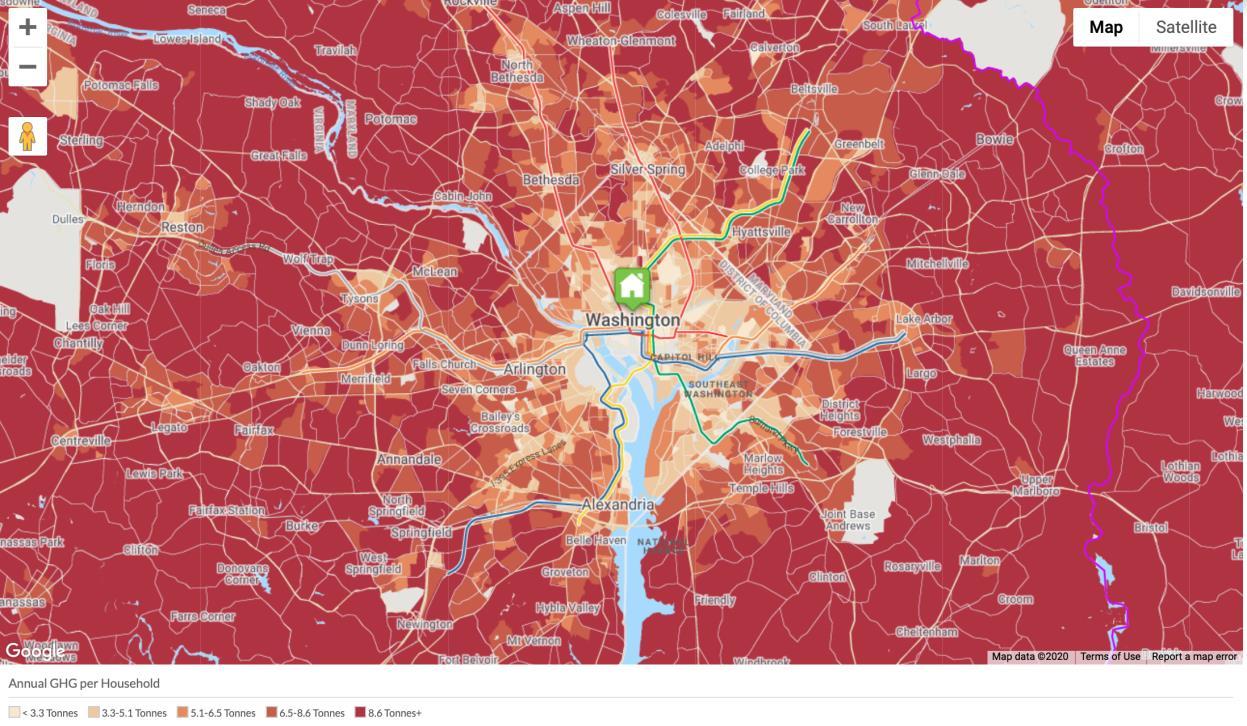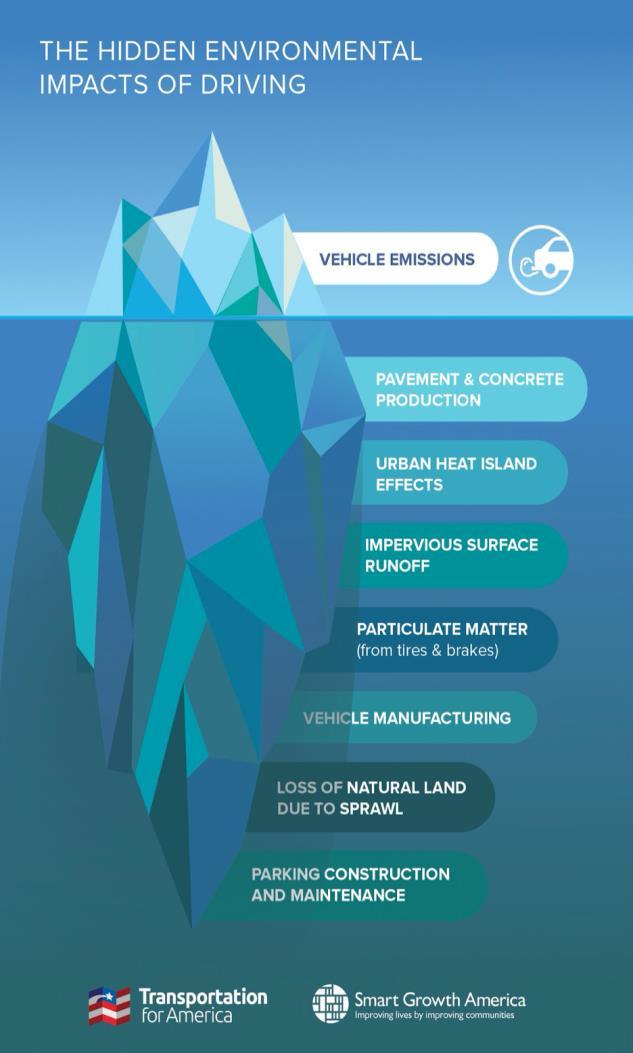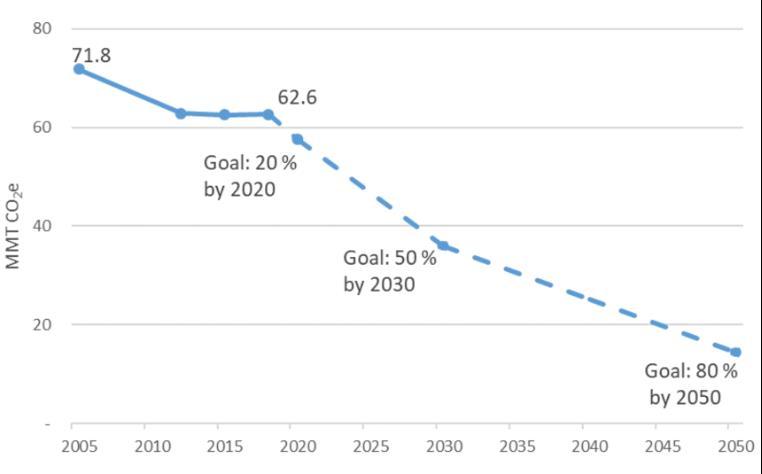
5 minute read
Equity, Livability, and Economic Co Benefits
WMATA’s ConnectGreaterWashington policy alternatives study showed that policies to concentrate the future growth in housing and jobs near our transit stations and address the east-west jobs-housing imbalance would have major benefits for the region. The land use scenario could decrease VMT by 12 percent by 2040 compared to conditions under the region’s adopted transportation plan and anticipated future land use, and would provide additional benefits for job accessibility, Metrorail revenues, and roadway congestion relief.26
Equity, Livability, and Economic Co-Benefits of Land Use, Mode Shift and Housing Strategies
To meet our climate protection goals, our region must reduce the need to drive for basic needs. Automobile-dependent land use and transportation networks place significant burdens on low-income households and workers in accessing daily needs. If we make it easier to use transit, or bike, and walk to get to work, school, shopping and services, our climate strategy will not just reduce GHG emissions, it will also improve equity and livability in the region. Co-benefits from reducing the need to drive include the following:
Total Externalities of Auto Vehicle Miles Traveled (VMT)
Every vehicle mile traveled in the United States costs society on net 18.38 cents per mile in 2017, accounting for congestion, crashes, and local air pollution as well as GHG emissions.27
Equity
Auto-oriented land use prevents walkable, transit-accessible neighborhoods. With a shortage of affordable housing in urban areas, many low-to-moderate income households are pushed to more distant auto-oriented suburbs that entail high personal transportation costs. Building more housing in cities and near transit can help expand job access and lower household transportation costs for families.28 What are “Co-Benefits”?
Many strategies to mitigate climate change have other societal benefits, such as improved health from reducing air pollution. These are referred to as “co-benefits”. A transportation-sector climate strategy focused just on electric cars will have much fewer cobenefits than a holistic approach that also addresses the need to drive for everyday needs.
12
A recent study found that “Households in location-efficient places spent significantly less on household transportation, enough to offset high housing costs. Walkable blocks and good transit especially contribute to these savings.” Although for the lowest-income families, the transportation savings were not enough to completely offset the housing costs. The authors recommend investments in housing and transportation and additional support for very low-income households: “Expanding location affordability regionally will also help to address climate change and expand access to job opportunities, goods, services, and other amenities.” 29
Climate strategies that emphasize broader mobility options, affordable housing, healthy and safe built environments, universal mobility, and more balanced regional job growth are consistent with the “Equitable Development” framework defined by the Local and Regional Government Alliance on Race & Equity.30 Washington Region Housing Location, Transportation Costs and GHG Emissions See Figures 7 and 8 on page 14, which show this relationship between housing location, household transportation costs, and GHG emissions from driving in the Washington region. Disproportionate Air Pollution Impacts
Air pollution from cars and trucks disproportionately burdens low-income households and people of color and has been linked to covid-19 susceptibility.31, 32 Deployment of cleaner cars and trucks, especially electric vehicles, can significantly reduce air pollution and provide billions of dollars in health benefits to DC, Virginia and Maryland.33, 34 Reducing VMT, in addition to addressing tailpipe air pollution emissions, also addresses non-tailpipe emissions, which primarily consist of particulate matter from tires and brakes and are a concern even with electric vehicles.35, 36
California’s Experience
The State of California recognizes that more equitable land use and transportation policies are consistent with GHG mitigation strategies: “Notably, many of the same policy responses to address transportation injustices and systematic racism in land use and transportation planning can simultaneously make communities stronger and more resilient, while reducing VMT impacts. These include affordable housing, safe, reliable transit, a range of affordable mobility options, and access to quality public education, medical care, and jobs all within the same community.”37
In addition to climate benefits, building more housing in cities and near transit can help expand job access and lower household transportation costs for families: • The average household in Gainesville, VA on the outer fringe of the region, can expect to spend about $15,000 per year in transportation expenses. • Meanwhile, a household in the transit-oriented Mosaic District of Fairfax County or within walking distance of the Wheaton Metro in Montgomery County can expect to spend roughly $10,000 per year. • Across the District of Columbia, the average is even lower, under $9,000 per year.
Source: Coalition for Smarter Growth analysis using Center for Neighborhood Technology H+T Index data
13
Figure 7: Washington Region Average Household Transportation Costs
Source: Image from the CNT Housing + Transportation Index. December 2020 https://htaindex.cnt.org/map/#
Figure 8: Washington Region Average Household Greenhouse Gas Emissions from Driving

Source: Image from the CNT Housing + Transportation Index. December 2020. https://htaindex.cnt.org/map/#
14
Safety
Per capita VMT correlates with per capita traffic deaths, and the U.S. leads developed countries in both of these measures. Newer traffic safety approaches look at auto travel demand management and the safety of all travel modes on our roadways.38 For example, cities with high rates of bicycling also tend to be safe for all roadway users. 39 Traditional roadway designs that favor high-speed car travel over other travel modes endanger pedestrians and bicyclists, with many low-income and people of color particularly at risk.40, 41
Other Environmental Impacts
The report Driving Down Emissions lists the other negative environmental impacts of automobilefocused transportation and land use, illustrated in the graphic on the right. A future of autodependence, even with EVs, will not address these other impacts.42 Non-tailpipe vehicle pollution has recently received more attention.43
Travel Time, Traffic Congestion
Simply electrifying every vehicle and continuing costly roadway expansions will not reduce travel times and congestion. New and expanded highways and arterials lead to more driving and eventually more congestion. This is a welldocumented phenomenon called “induced demand.” 44 Here in the DC region, TPB showed that travel demand management and regional land use strategies were most effective at reducing hours of vehicle delay.45, 46

Source: Image from Driving Down Emissions, page 9
Land Use
Tackling the sprawl caused by decades of autocentric transportation and land use policies will reduce VMT and have many other benefits for open space preservation, public infrastructure and service costs, household affordability and resilience, improved transportation options (mobility for non-drivers), congestion and travel time impacts, traffic safety, economic opportunity and resilience, social problems (poverty, crime, mental illness), public fitness and health, energy consumption, pollution emissions, and economic development.47
15








